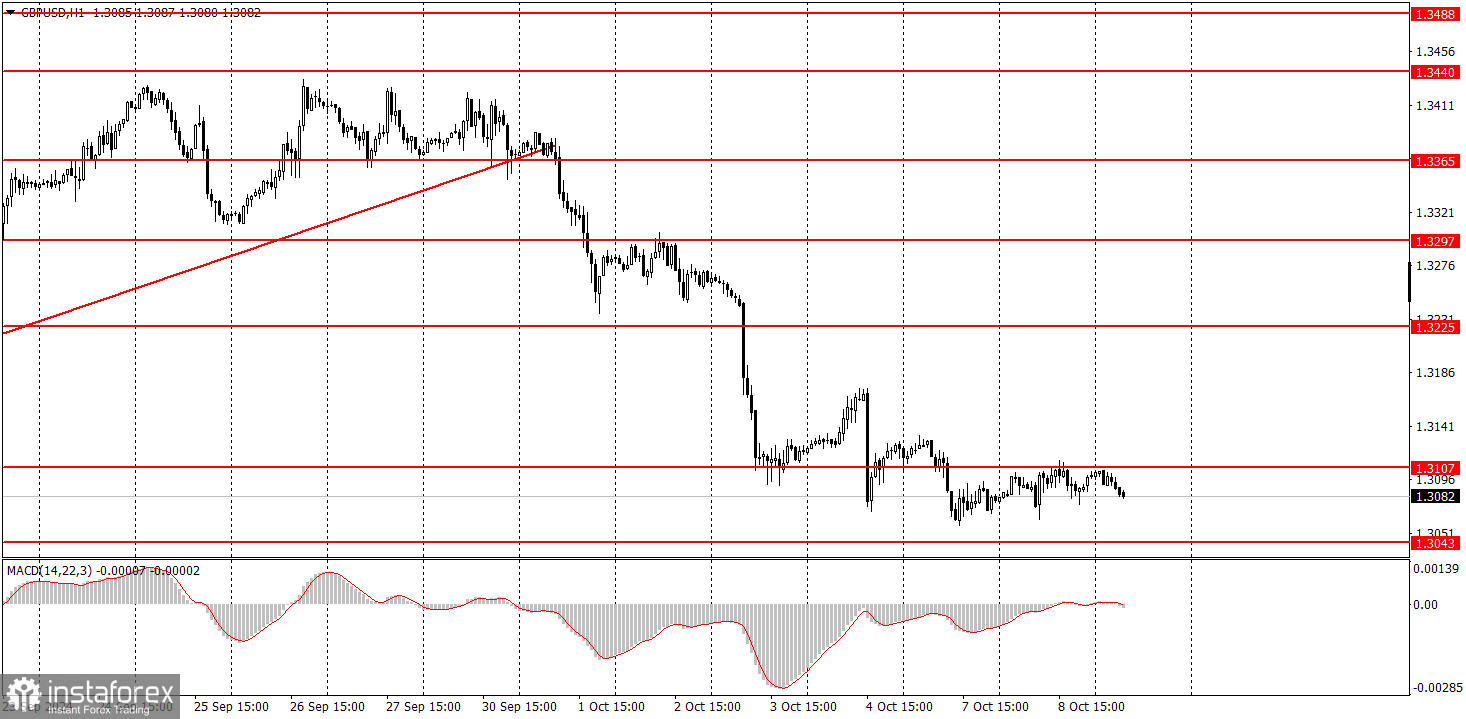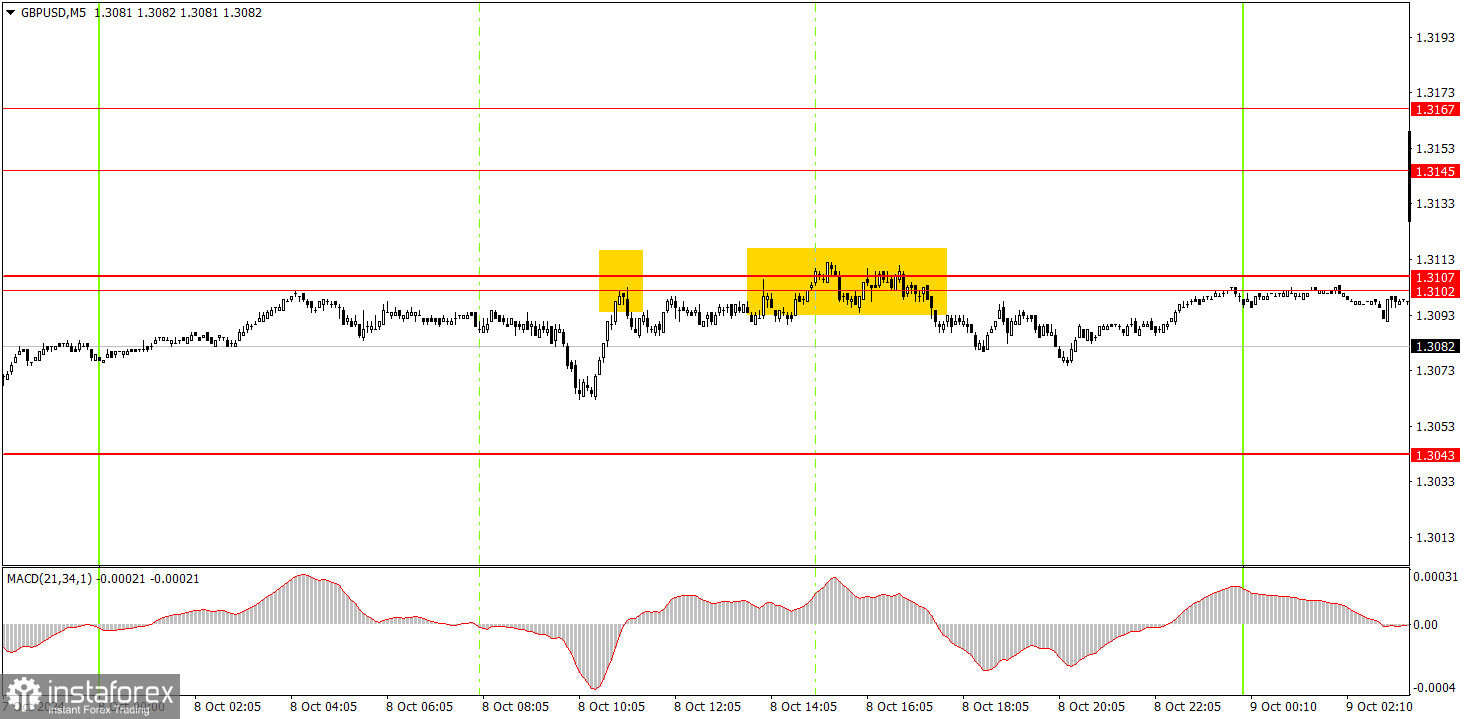Analysis of Tuesday's Trades
1H Chart of the GBP/USD Pair

On Tuesday, the GBP/USD pair once again failed to correct and couldn't even overcome the nearest resistance level. Thus, the technical picture suggests that the decline may continue without a correction. Of course, we are still awaiting the U.S. inflation report this week, which could trigger a drop in the U.S. dollar if the result falls short of expectations. However, this report has yet to be released, so there is no point in speculating about it. Moreover, the inflation figure no longer has the same degree of influence on monetary policy and the dollar's exchange rate as it did a few months ago. The Federal Reserve has begun easing and will continue regardless. The market was waiting for the Fed to start lowering rates, and now that it has, there are no more reasons to sell the dollar.
5M Chart of the GBP/USD Pair

In the 5-minute timeframe on Tuesday, the price bounced twice from the 1.3102-1.3107 area and a third time during the night. Despite not seeing a substantial decline, the downward movement may continue today. There was no reason to close the short positions as no buy signals were generated. Therefore, it is possible to remain in short positions, targeting 1.3043.
How to Trade on Wednesday:
The GBP/USD pair has broken the upward trend in the hourly time frame. The U.S. dollar has started its long-awaited rise, but caution is advised with selling since the pair haven't even attempted a correction, and the U.S. inflation report is still ahead. However, in the medium-term perspective, we fully support the pair's decline, as we believe it is the only logical outcome.
On Wednesday, the British pound may continue its sluggish decline, as it failed to consolidate above the 1.3102-1.3107 area. The macroeconomic background is absent today, so strong movements are not expected.
In the 5-minute time frame, you can trade around the following levels: 1.2913, 1.2980-1.2993, 1.3043, 1.3102-1.3107, 1.3145-1.3167, 1.3225, 1.3272, 1.3365, 1.3428-1.3440, 1.3488, 1.3537. On Wednesday, no significant events are scheduled in the UK or the U.S., so volatility may remain low throughout the day, and the British pound has not shown any desire for correction so far.
Basic Rules of the Trading System:
- The strength of a signal is determined by the time it takes to form (bounce or break through a level). The less time it takes, the stronger the signal.
- If two or more trades were opened near a particular level based on false signals, all subsequent signals from that level should be ignored.
- In a flat market, any pair can generate a lot of false signals or none at all. In any case, it's best to stop trading at the first signs of a flat market.
- Trades should be opened during the period between the start of the European session and the middle of the US session, after which all trades should be manually closed.
- In the hourly time frame, it's preferable to trade based on MACD signals only when there is good volatility and a trend confirmed by a trendline or trend channel.
- If two levels are very close to each other (between 5 and 20 pips), they should be treated as a support or resistance zone.
- When moving 20 pips in the intended direction, a Stop Loss should be set to breakeven.
What's on the Charts:
Support and Resistance Price Levels: These levels serve as targets when opening buy or sell positions. They can also be used as points to set Take Profit levels.
Red Lines: These represent channels or trend lines that display the current trend and indicate the preferred trading direction.
MACD Indicator (14,22,3): The histogram and signal line serve as an auxiliary indicator that can also be used as a source of trading signals.
Important Speeches and Reports (always found in the news calendar) can significantly impact the movement of a currency pair. Therefore, trading should be done with maximum caution during their release, or you may choose to exit the market to avoid a sharp price reversal against the preceding movement.
For Beginners Trading on the Forex Market: It's essential to remember that not every trade will be profitable. Developing a clear strategy and practicing money management is key to achieving long-term success in trading.





















